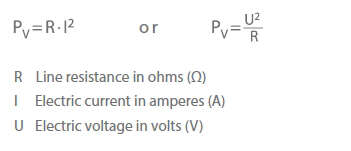Power loss
Power loss (Pv) is the difference between the input and output power of a device, apparatus, pump set, or process. With electrical and electronic devices, as well as pumps, apparatuses and processes, this undesirable loss is converted into heat (see Head, Efficiency).
Power loss arises when transferring electrical energy via cables, for example.
The loss of power when transferring electrical energy depends directly on the line resistance (R) and, consequently, on the line diameter, as well as on the material used and the electric current flowing (I). It can be calculated by dividing the voltage drop by the line resistance R (U):

Particularly when transferring and converting energy, power loss should be considered as a loss that should be minimised, as is the case with gear units (mechanical energy), transformers (electrical energy), motors (conversion of electrical to mechanical energy), and pumps (conversion of mechanical to hydraulic energy). The resulting lost heat is dissipated by means of radiation, heat transfer, or convection (cooler).
